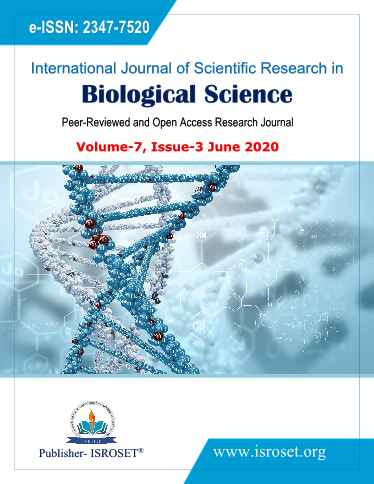Modelling and Analysis of Covid-19 Spread Among People in a Queue
Keywords:
Corona Virus, Computer simulation, Covid-19, Virus TransmissionAbstract
Covid-19 is a serious respiratory disease that quickly spread around the world. It is essential to understand how coronavirus transmits from one person to another and this knowledge will help to limit the spread of the Coronavirus. A computer simulation is used to understand the possibilities of spreading of Coronaviruses among people standing in the queue. The model parameter that represents the height of the person is fed with 1.51 meters to 1.75 meters and inhaled virus count is determined. Repeated the study to find the effect of the transmission of coronavirus on positions 1 to 5 from the infected person in the queue. In another experiment, the waiting time in the queue is varied from 30 seconds to 150 seconds. Also, the distance between people in the queue is varied from 0.5 meters to 3 meters and determined the risk of getting infected. The relative height of the person with reference to the patient is one of the key factors that determine the risk of infection. Also observed that the people are more susceptible to Covid-19 when they are just behind the infected person and spend more time in the queue. The increased distance between people in the queue has not reduced the probability of spreading of coronavirus at least up to 3 meters. In summary, this study suggests that in addition to social distancing and personal hygiene, wearing face masks will further reduce the probability of spreading of Covid-19 in social gatherings.
References
Richard James Thomas: ?Particle size and pathogenicity in the respiratory tract? Virulence pp 847?858;2013; doi: 10.4161/viru.27172
Kutter JS, Spronken MI, Fraaij PL, Fouchier RAM, Herfst S, ?Transmission routes of respiratory viruses among humans? Curr Opin Virology.28:142-151,2018
Jianyun Lu et al, ?COVID-19 Outbreak Associated with Air Conditioning in Restaurant, Guangzhou, China, 2020?EID Journal,Vol 26, Number 7, 2020 doi: 10.3201/eid2607.200764
Hualing Zhang, Dan Li, Ling Xie, Yimin Xiao, ?Documentary Research of Human Respiratory Droplet Characteristics?Procedia Engineering, Vol 121, Pages 1365-1374,2015
Daniel Verreault, Sylvain Moineau, Caroline Duchaine, ?Methods for Sampling of Airborne Viruses? Microbiol Mol Biol Rev. 72(3): 413?444,2008 doi: 10.1128/MMBR.00002-08
Anthony R. Fehr, Stanley Perlman, ?Coronaviruses: An overview of their replication and Pathogenesis? Coronaviruses pp 1-23,2015 doi: 10.1007/978-1-4939-2438-7_1
Judith Vajda, Dennis Weber, Dominik Brekel, Boris Hundt, Egbert Muller, ?Size distribution analysis of Influenza virus particles using size chromatography? Journal of Chromatography A Vol 1465, Pages 117-125,2016
Dewald Schoeman, Burtram C. Fielding, ?Coronavirus envelope protein: current knowledge? Virology Journal Vol 16, Article number: 69,2019 Doi: 10.1186/s12985-019-1182-0
William C. Hinds, ?Aerosol Technology Properties, Behavior, and Measurement?, A WILEY-INTERSCIENCE PUBLICATION, Wiley, 1982
Raymond Tellier, ?Review of Aerosol Transmission of Influenza A Virus?, Emerg Infect Dis 12(11):1657-62, 2006 doi: 10.3201/eid1211.060426.
Anice C. Lowen, Samira Mubareka, John Steel, Peter Palese, ?Influenza Virus Transmission Is Dependent on Relative Humidity and Temperature?, PLOS Pathogens 3(10):1470-6,2007 doi: 10.1371/journal.ppat.0030151
Wan Yang, Linsey C. Marr, ?Dynamics of Airborne Influenza A Viruses Indoors and Dependence on Humidity?PLOS ONE, June 24, 2011, https://doi.org/10.1371/journal.pone.0021481
David A. Edwards et al, ?Inhaling to mitigate exhaled bioaerosols?, Proc Natl Acad Sci U S A. 101(50): 17383?17388,2004. doi: 10.1073/pnas.0408159101
Patricia Fabian et al, ?Influenza Virus in Human Exhaled Breath: An Observational Study?, PLoS One.3(7): e2691,2008 doi: 10.1371/journal.pone.0002691
Warren H. Finlay, ?Motion of a single aerosol particle in a fluid? The Mechanics of Inhaled Pharmaceutical Aerosols, London: Academic Press; pp. 17?45,2001
D.G. Sharp, A.R. Taylor, I.W. McLean, Dorothy Beard, J.W. Beard, ?Desnisties and Sizes of the Influenza Viruses A (PR8 STRAIN) and B (LEE STRAIN) and the Swine Influenza Virus? J. Biol. Chem. 159:29-44,1945
G. J. HARPER, ?Airborne micro-organisms: survival tests with four viruses?, J Hyg (Lond). 59(4): 479?486, 1961 doi: 10.1017/s0022172400039176
Aaron J. Prussin et al, ?Survival of the Enveloped Virus Phi6 in Droplets as a Function of Relative Humidity, Absolute Humidity, and Temperature?, Appl Environ Microbiol, 84(12):e00551-18,2018 doi: 10.1128/AEM.00551-18
Anice C. Lowen, John Steel, ?Roles of Humidity and Temperature in Shaping Influenza Seasonality?, Journal of Virology Vol 88, No 14, p.7692?7695,2014,DOI: 10.1128/JVI.03544-13
Yi Wang et al, ?Evaporation and Movement of Fine Water Droplets Influenced by Initial Diameter and Relative Humidity? Aerosol and Air Quality Research Vol 16, Issue 2, 2016, DOI: 10.4209/aaqr.2015.03.0191
Siddhartha Dan, Deepshikha Sharma, Mahasweta Mandal, Deepti Sharma, ?Incidence of COVID-19 and Its Correlation between Temperature and Population Density?, ISROSET, Vol.7, Issue.2, pp.134-141, 2020
Downloads
Published
How to Cite
Issue
Section
License

This work is licensed under a Creative Commons Attribution 4.0 International License.
Authors contributing to this journal agree to publish their articles under the Creative Commons Attribution 4.0 International License, allowing third parties to share their work (copy, distribute, transmit) and to adapt it, under the condition that the authors are given credit and that in the event of reuse or distribution, the terms of this license are made clear.







